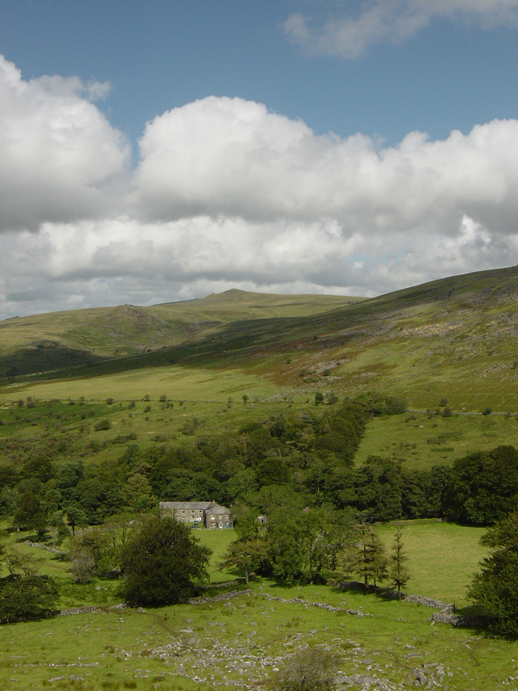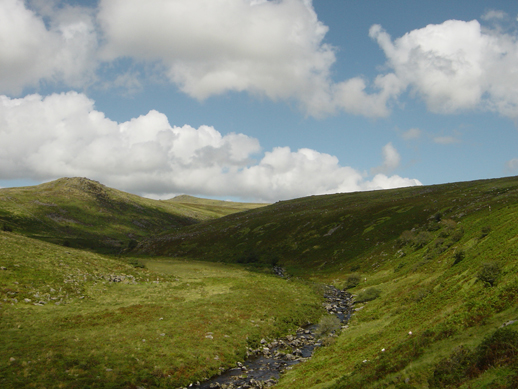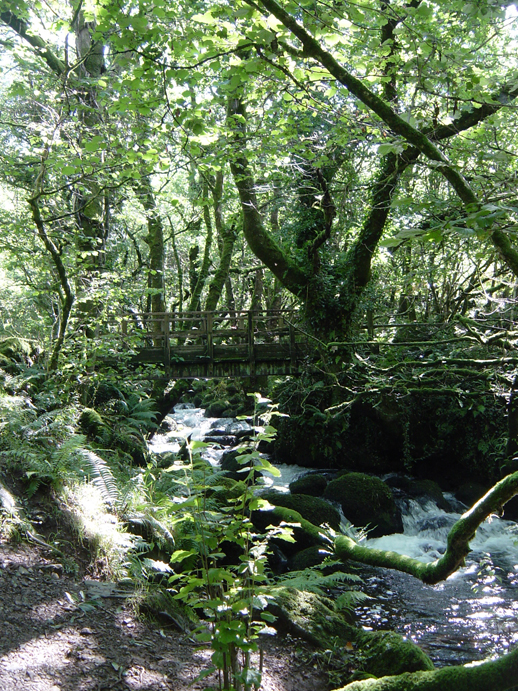 Tavy Cleave from Bagga Tor with Baggator Farm in foreground
Tavy Cleave from Bagga Tor with Baggator Farm in foreground
Words & pictures from West Country correspondent Mr. Alex Smith.
Tavy Cleave.
There is no firing on the moors in August. All the ranges go quiet for the month, granting an easement to the walkers, the mountain bikers and the horse riders. They leave behind only the evidence of occupation; the range markers, the boards and flags, the observation huts and the warning signs that warn “it may explode and kill you”. This keens your eye when you get to walk the ranges but mostly we just find spent parachute flares and the sad remains of garishly designed civilian helium balloons. Set free from the towns and cities on an evangelical mission to spread the word to the world, bearing tags with messages of hope, love and remembrance, one can’t help but feel a stab of poignancy as they loll untidily on grassy plains and catch in the lower branches of riverside mountain ash, betrayed by leaking seams and the vagaries of mass production until they are not quite lighter than air any more.
 Looking up the Cleave from high on Standon Down
Looking up the Cleave from high on Standon Down
Tavy Cleave, our destination, is, surely, one of the jewels of the moor. An imposing high sided river valley with tors that tower over the snaking Tavy, it sits in the Willsworthy range and, on non-firing days, it is easy to access, making it a favourite with visitors to the area who’ve read the brochures and noted the directions but ignored the good advice enclosed to dress for rain on sunny departures and invest in stout walking shoes and socks built for the purpose. The two of us today could have, if we had wished, driven to points close to Tavy Cleave, as many of these visitors would have done, and followed the leat along to the Cleave from car parks at Willsworthy, Lanehead or points close to Lydford. And, in so doing, we would have likely passed those who had set out a little less prepared. We might have looked a little keen to them, the reasoning behind our boots and gaiters lost to them in the grassy paths of the open upland stretches. But the easy paths soon turn to stony tracks that gradually become wetter and less distinct, mined with thistles and calf-shredding gorse and occasionally forking off from the proscribed route into paths wished into reality by those who desired a straighter line. And as they make their way back from the precipice or bog or bramble thicket that blocked their way, each step has added more evidence of wear to the ground to fool those who follow into believing that this might be a shorter route.
As the going got tougher we could have encountered the winded and the seated, resting awhile before making their way up steep sections, their cherry faces shining up as we pass and their dwindling resolve taunted by the metronomic clicking of our sticks with their beat that both measures our pace and broadcasts it at the same moment. The rhythm that states our intention to continue on is wedded to the air we carry; that we know where we’re going and look forward to that which is there. I could have put myself in their Nikes and looked up at myself and had a good guess at what they were thinking. Only fifty paces on from their last intermission and the rest of the rise measured out in further, increasingly frequent intervals as their baseball caps squeeze their craniums like some Native American torture from the movies of their youth and their trainers rub against the man-made fibres of their socks turning them into some microplane for the heel. Looking up at me with my inclusive smile of satisfaction at a day well spent, the appropriate gear and the short sung hello implicit with the understanding that there is no need for a reply even if they did have the wind at their disposal. “Berghaus wanker!” I think, or perhaps some longer vamp on a similar theme.
And that’s why I come at it from a different angle, through deep moors and rickety farms and over distant tors that are really not all that far away. It is best, in my book, to come across the real gems at the midway point of a more substantial trek. I want to be half-spent when I get there, to eat my lunch in a place of rare beauty and solitude, one that only a relative few get to know and even fewer can get to visit throughout the changing seasons. I sometimes wish that I could pick up the monumental tors and wooded river valleys that are situated, through no fault of their own, close to invading roads and conurbations and move them even further into the moor so that only those willing to earn the right could glory in them. But that is a view that will doubtless soften as my age catches up with me and some form of wheeled transport eventually becomes the only way to make my weekly pilgrimage. It will be then that I shall feel thankful for Foggintor Quarry and Bellever Tor with their handy parking and visitor centres and a nice cup of tea in the village. But not just yet.
The route in brief:
We parked in Peter Tavy and headed up Colly Brook, leaving early to cross the road to Smeardon Down. Then up to Stephen’s Grave and a path below White Tor and around to Langstone standing stone. A long flat track to White Barrow, just below Cocks Hill and north along the path to Bagga Tor and lunch. Views over the perfectly circular South Common Plantation. A path to Brousentor Farm and a track to Standon Farm and its sheep enclosures made of corrugated metal, broken wooden palings and baling twine. Up onto Standon Down where we put up a heron in the valley below. Staying high on the south side of the cleave for much of its length and then down to cross the Tavy a little below where Amicombe Brook and Rattle Brook join. Return on the other side at river’s edge, wet underfoot, and up along the leat to Nattor Farm and Lanehead. Back along country lanes to Willsworthy Bridge, Hilltown, Cudlipptown and a return to Peter Tavy. A proper day of it.
